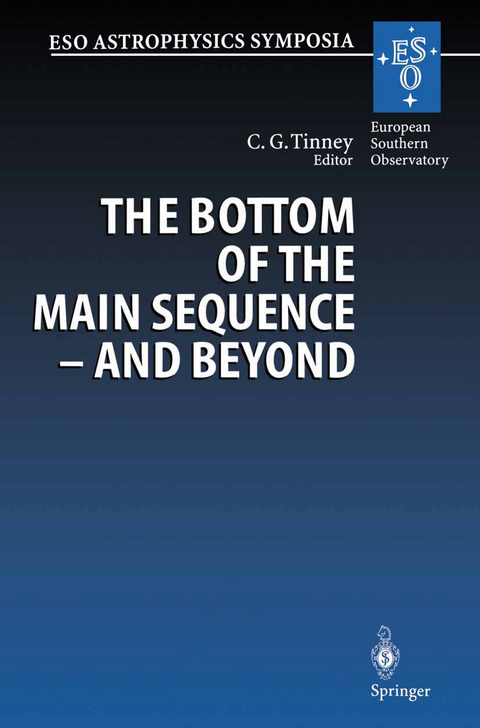
The Bottom of the Main Sequence — And Beyond
Springer Berlin (Verlag)
978-3-662-22482-3 (ISBN)
I Modelling Very Low-Mass Stars and Brown Dwarfs.- The Quiet Lives of Very Low Mass Stars and Brown Dwarfs.- Luminosity Functions and the Mass Function.- The Evolution of Low-Mass Stars.- The Equation of State for the Interiors of Low-Mass Objects.- M (sub)Dwarf Model Atmospheres: The Next Generation.- Spectra and Colours of Brown Dwarfs.- II Surveys in the Field.- Photometric and Astrometric Surveys for Low-Mass Field Stars.- VLM Stars Toward the Barnard 5 Molecular Cloud.- Brown Dwarf Candidates from Digitally Stacked Schmidt Plates.- How Complete is Our Knowledge of the Nearby Stars?.- A Photographic Survey of the Southern Sky.- III Searches for Companions.- The Solar Neighbors in the Murky Depths of the Main Sequence.- A Search for Infrared Companions to White Dwarfs.- Two Faint Companions to the Nearby M-dwarf LHS1070.- Sub-arcsecond Imaging of G29-38 Using Adaptive Optics.- Brown Dwarfs and Planets Around Solar-type Stars: Searches by Precise Velocities.- SHARP Images of the Pre-main Sequence Star V536 Aquilae: A Binary with a Low-Mass Companion.- Exploration of the Lower Main Sequence Among Wide Binaries.- IV Observables.- The Temperature Scale for Cool Dwarfs.- Parallaxes and Absolute Magnitudes for VLM Stars.- Southern Stars Near the Substellar Boundary: An Update.- Classification Spectroscopy of M Dwarfs from 0.6 to 2.4 Microns.- The Design of the Low-Mass Binaries Database.- The Mass-Luminosity Relation for M-dwarfs.- Lithium and the Nature of Brown Dwarf Candidates.- V Very Low-Mass Stars and Brown Dwarfs in Clusters.- Star Formation and the Initial Mass Function.- Surveys of Nearby Clusters for Low-Mass Stars and Brown Dwarfs.- The VLM Main Sequence in Praesepe.- Near-infrared Observations of Low-Mass Objects in NGC 2024.- HST Photometry of Low-Mass Starsin Open Clusters.- Spectroscopy of M Type Stars in the ? Persei Open Cluster.- Low-Mass Stars and Brown Dwarfs in the Trapezium Cluster.- VI Activity.- Surface Activity and Rotation in Low-Mass Stars.- The Frequency of Magnetic Activity in Field M Dwarfs.- Chromospheric and Coronal Activity of Low-Mass Stars in the Pleiades.- Moderate Resolution Spectroscopy of VLM and BD-Candidate Members of the Pleiades and Hyades.- VII The Halo.- The Pop. II Lower Main Sequence: Some Properties and a Luminosity Function Determination.- Low-Mass Objects and the Dark Matter in the Halo.- Faint Companions to G/K Halo Subdwarfs.- On the Pop. II IMF: Many More Brown Dwarfs?.- Unveiling the IMF of Galactic Globular Clusters: the Case of NGC 1261.- A Review of Gravitational Microlensing Experiments.- VIII The Future in the Infrared.- VLM Stars and Brown Dwarfs from 2MASS and DENIS.- Searching for Low-Mass Stars with DENIS. Preliminary Results on a Star Forming Region: Orion.- Brown Dwarfs in the ISO Central Programme.- IX Conference Summary.- Summary Remarks: Hitting Bottom?.- Author Index.
| Erscheint lt. Verlag | 23.8.2014 |
|---|---|
| Reihe/Serie | ESO Astrophysics Symposia |
| Zusatzinfo | XVII, 309 p. 134 illus. |
| Verlagsort | Berlin |
| Sprache | englisch |
| Maße | 155 x 235 mm |
| Gewicht | 504 g |
| Themenwelt | Naturwissenschaften ► Geowissenschaften ► Geophysik |
| Naturwissenschaften ► Physik / Astronomie ► Astronomie / Astrophysik | |
| Schlagworte | Cluster • Clustering • density • Gravitation • Gravity • Main sequence • Photometry • Planet • spectroscopy • Star • star formation • Stars • White Dwarf |
| ISBN-10 | 3-662-22482-8 / 3662224828 |
| ISBN-13 | 978-3-662-22482-3 / 9783662224823 |
| Zustand | Neuware |
| Haben Sie eine Frage zum Produkt? |
aus dem Bereich


